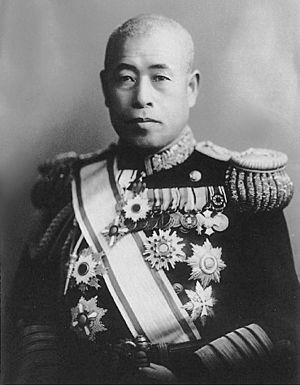Isoroku Yamamoto facts for kids
Quick facts for kids
Isoroku Yamamoto
|
|
|---|---|

Admiral Yamamoto (circa 1940)
|
|
| Native name |
山本 五十六
|
| Born | April 4, 1884 Nagaoka, Niigata, Empire of Japan |
| Died | April 18, 1943 (aged 59) near Panguna, Bougainville, Territory of New Guinea |
| Buried |
Tama Cemetery, Tokyo
|
| Allegiance | |
| Service/ |
|
| Years of service | 1904–1943 |
| Rank | |
| Commands held | Isuzu, Akagi, 1st Carrier Division, Naval Aviation Bureau, 1st Fleet, Combined Fleet, 1st Battleship Division |
| Battles/wars |
|
| Awards |
|
| Alma mater | Harvard University (1919–1921) Imperial Japanese Naval Academy (1901–1904) |
| Spouse(s) |
Reiko Mihashi
(m. 1918) |
| Other work | Vice-Minister of the Navy |
Isoroku Yamamoto (山本 五十六, Yamamoto Isoroku, April 4, 1884 – April 18, 1943) was a very important Japanese admiral. He was a Marshal Admiral in the Imperial Japanese Navy (IJN). He was also the main commander of Japan's navy, called the Combined Fleet, during World War II.
Yamamoto held many important jobs in the Japanese Navy. He helped make many changes and improvements, especially in developing planes for the navy. He was the commander during the early parts of the Pacific War. He led major attacks like the attack on Pearl Harbor and the Battle of Midway.
Yamamoto was killed in April 1943. American code breakers found out his flight plans. This allowed the United States Army Air Forces to shoot down his plane. His death was a big blow to Japan's spirits during World War II.
Contents
Early Life and Family
Isoroku Yamamoto was born on April 4, 1884. His birth name was Isoroku Takano. He was born in Nagaoka, a city in Niigata, Japan.
His father, Sadayoshi Takano, was a samurai. The name "Isoroku" means "56" in old Japanese. This was because his father was 56 years old when Isoroku was born.
In 1916, Isoroku was adopted by the Yamamoto family. This was a common practice for samurai families who didn't have sons. It helped keep the family name and traditions going. After this, he took the Yamamoto name. In 1918, Isoroku married Reiko Mihashi. They had two sons and two daughters together.
Yamamoto's Death in World War II

After a defeat at Guadalcanal, Yamamoto decided to visit troops in the South Pacific. During this trip, American forces planned an operation to kill him.
On April 14, 1943, the United States Navy's intelligence team, called "Magic", found and decoded a secret message. This message had all the details of Yamamoto's trip. It included when and where he would arrive and leave. It also said how many and what types of planes would fly with him.
The message showed that Yamamoto would fly from Rabaul to Balalae Airfield. This airfield was on an island near Bougainville in the Solomon Islands. His flight was planned for the morning of April 18, 1943.
Admiral Chester W. Nimitz decided to go ahead with the mission. He got approval from Admiral William Halsey Jr.. On April 17, the mission was approved to stop and shoot down Yamamoto's plane. Lockheed P-38 Lightning planes from the United States Army Air Forces were chosen. These planes had enough range to reach the target. The pilots were told they were going after an "important high officer."
On the morning of April 18, Yamamoto's two Mitsubishi G4M transport planes left Rabaul. They flew for about 315 mi (507 km). Sixteen P-38s met them over Bougainville. A dogfight started between the P-38s and six Japanese escort planes called Mitsubishi A6M Zeroes.
First Lieutenant Rex T. Barber attacked the first Japanese transport plane. This was Yamamoto's aircraft. He fired at it until smoke came from its left engine. Yamamoto's plane then crashed into the jungle.
Yamamoto's staff burned his remains in Buin, Papua New Guinea. His ashes were then taken back to Tokyo on the battleship Musashi. This was his last flagship.
He was given a full state funeral on June 5, 1943. After his death, he was given the title of Marshal Admiral. He also received the Order of the Chrysanthemum (1st Class). He was also given Nazi Germany's Knight's Cross of the Iron Cross with Oak Leaves and Swords. Some of his ashes were buried in the public Tama Cemetery, Tokyo. The rest were buried at his family's temple in Nagaoka City. Admiral Mineichi Koga took over as commander-in-chief of the Combined Fleet after Yamamoto.
Yamamoto in Movies
Since World War II ended, many movies have shown Isoroku Yamamoto. Both Japanese and American films have featured his character.
One famous movie is Tora! Tora! Tora! from 1970. Japanese actor Sô Yamamura played Yamamoto in this film.
Images for kids
See also
 In Spanish: Isoroku Yamamoto para niños
In Spanish: Isoroku Yamamoto para niños




